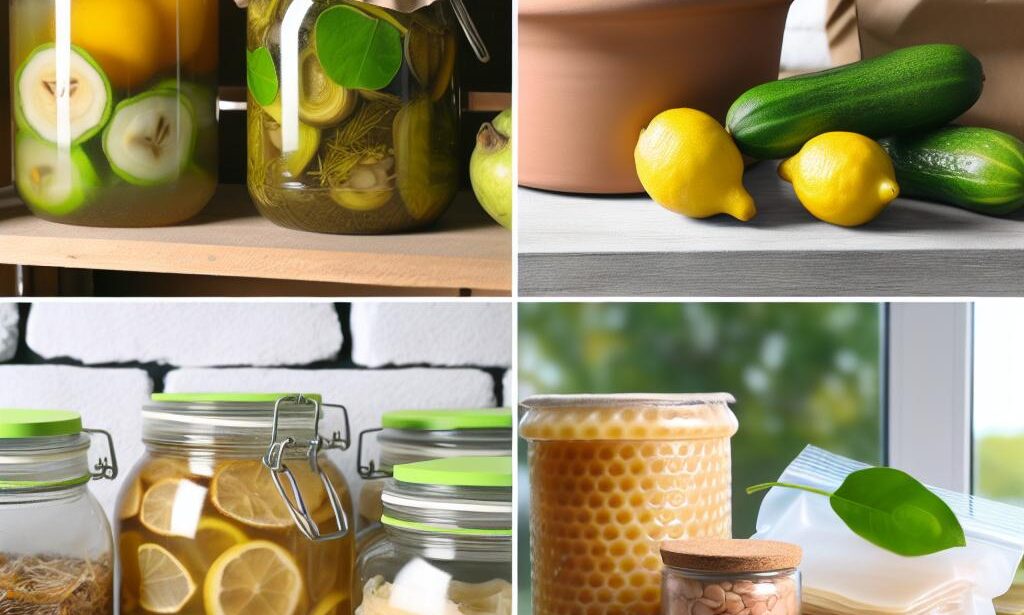In today’s world of increasing concern for sustainability and food preservation, finding green techniques for long-lasting food storage has become a priority for many individuals and households. From utilizing reusable containers to exploring alternative methods such as fermentation and dehydration, there are a variety of eco-friendly options available to help extend the shelf life of perishable items while reducing waste. In this article, we will explore some of the most effective green techniques for long-lasting food storage that can help you save money, reduce your carbon footprint, and ensure that your food stays fresh for longer periods of time.
Table of Contents
- Eco-Friendly Alternatives for Food Preservation
- Sustainable Packaging Solutions for Extended Shelf Life
- Natural Methods to Prevent Food Spoilage
- Environmentally-Friendly Practices for Storing Fresh Produce
- Tips for Long-Term Food Storage Without Harmful Chemicals
- Q&A
- To Wrap It Up
Eco-Friendly Alternatives for Food Preservation
When it comes to preserving food in an eco-friendly way, there are several green techniques that can help extend the shelf life of your groceries while reducing waste. One alternative is using beeswax wraps to cover fruits, vegetables, and leftovers instead of plastic wrap. Beeswax wraps are reusable, biodegradable, and can help keep your food fresh for longer periods of time.
Another eco-friendly option for food preservation is investing in glass or stainless steel containers for storing leftovers or meal prepping. These containers are durable, non-toxic, and can be easily washed and reused, eliminating the need for single-use plastic containers. Additionally, using airtight containers can help prevent food spoilage and extend the freshness of your food.

Sustainable Packaging Solutions for Extended Shelf Life
When it comes to preserving food for extended periods of time, sustainable packaging solutions play a crucial role in reducing food waste and environmental impact. By utilizing green techniques for long-lasting food storage, we can not only extend the shelf life of products but also minimize the use of harmful materials that contribute to pollution.
One effective method for sustainable packaging is utilizing biodegradable materials such as **bioplastics** made from renewable resources like corn starch or sugarcane. These materials break down naturally over time, reducing the amount of waste that ends up in landfills. Additionally, incorporating **recycled** content into packaging helps to minimize the use of virgin materials and decrease the overall carbon footprint of the product.
| Benefits of Sustainable Packaging: |
|---|
| 1. Extends shelf life of products |
| 2. Reduces food waste |
| 3. Minimizes environmental impact |

Natural Methods to Prevent Food Spoilage
When it comes to preventing food spoilage, there are several natural methods that can help extend the shelf life of your groceries. By incorporating these green techniques into your food storage routine, you can reduce waste and save money in the long run.
One effective method is proper ventilation for fruits and vegetables. Storing produce in a well-ventilated area can help prevent mold growth and extend their freshness. Additionally, using beeswax wraps or reusable silicone bags instead of plastic wrap can help keep food fresh for longer periods of time.
Another eco-friendly option is using natural preservatives such as vinegar, salt, and sugar to extend the shelf life of homemade jams, pickles, and sauces. These ingredients not only help prevent spoilage but also add flavor to your dishes. By incorporating these green techniques into your food storage routine, you can reduce waste and save money in the long run.

Environmentally-Friendly Practices for Storing Fresh Produce
When it comes to storing fresh produce in an environmentally-friendly way, there are several green techniques that can help extend the shelf life of your fruits and vegetables while reducing waste. By implementing these practices, you can not only save money but also contribute to a more sustainable lifestyle.
One of the most effective ways to store fresh produce is by using reusable containers made from eco-friendly materials such as glass or stainless steel. These containers help to keep fruits and vegetables fresh for longer periods of time compared to plastic bags or containers. Additionally, storing produce in the refrigerator can help maintain their freshness and prevent spoilage.
Another green technique for storing fresh produce is by utilizing natural preservation methods such as pickling, fermenting, or dehydrating. These methods not only help to extend the shelf life of fruits and vegetables but also add unique flavors and textures to your dishes. By incorporating these environmentally-friendly practices into your food storage routine, you can reduce food waste and minimize your environmental impact.

Tips for Long-Term Food Storage Without Harmful Chemicals
When it comes to long-term food storage, it’s important to find ways to preserve your food without harmful chemicals. Luckily, there are plenty of green techniques you can use to keep your food fresh for longer periods of time. Here are some tips to help you store your food without the use of harmful chemicals:
- Mason Jars: Use mason jars to store dry goods such as rice, pasta, and beans. These jars are a great eco-friendly option and can help keep your food fresh for extended periods of time.
- Beeswax Wraps: Instead of using plastic wrap, opt for beeswax wraps to cover fruits, vegetables, and leftovers. These wraps are reusable and can help reduce your plastic waste.
- Vacuum Sealing: Invest in a vacuum sealer to remove air from your food packaging, which can help prevent spoilage and extend the shelf life of your food.
| Food Item | Storage Method |
|---|---|
| Flour | Mason Jar |
| Fruits | Beeswax Wraps |
| Meat | Vacuum Sealing |
Q&A
Q: What are some green techniques for long-lasting food storage?
A: Some green techniques for long-lasting food storage include using glass containers instead of plastic, utilizing reusable beeswax wraps or silicone bags, and investing in a vacuum sealer to extend the shelf life of perishable items.
Q: How can using glass containers help with long-lasting food storage?
A: Glass containers are a more sustainable option compared to plastic because they are reusable and do not leach harmful chemicals into food. They also help to maintain the freshness of food for longer periods of time.
Q: What are beeswax wraps and how can they be used for food storage?
A: Beeswax wraps are a natural and reusable alternative to plastic wrap. They can be used to cover bowls, wrap sandwiches, or store cheese and produce. Beeswax wraps help to keep food fresh and reduce the need for single-use plastic.
Q: How can a vacuum sealer help with long-lasting food storage?
A: A vacuum sealer removes air from packaging, which helps to prevent oxidation and spoilage of food. By vacuum sealing items such as meats, fruits, and vegetables, their shelf life can be extended significantly, reducing food waste.
Q: Are there any other green techniques for long-lasting food storage?
A: Other green techniques for long-lasting food storage include using compostable or biodegradable food storage bags, storing food in a cool, dark place, and properly rotating food items to ensure older items are used first. Additionally, utilizing a root cellar or canning fruits and vegetables can also help to preserve food for longer periods of time.
To Wrap It Up
In conclusion, implementing green techniques for long-lasting food storage not only helps reduce food waste and save money, but also contributes to a more sustainable and environmentally-friendly lifestyle. By utilizing methods such as proper packaging, optimal temperature control, and strategic organization, you can extend the shelf life of your food items while minimizing your carbon footprint. Remember to always prioritize food safety and hygiene practices when storing your food, and consider incorporating these green techniques into your daily routine for a more eco-conscious approach to food preservation. Thank you for reading and we hope these tips will help you make more informed choices when it comes to storing your food for the long haul.

